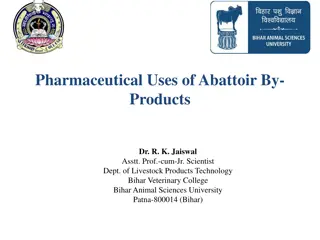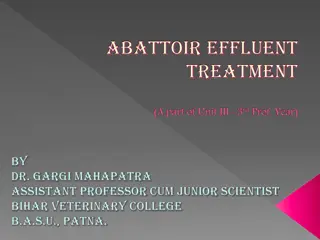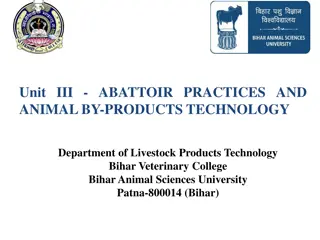Abattoir Practices and Bone Products Technology Overview
Bone constitutes a significant portion of the dressed carcass weight, with various types such as fresh green bone and desert bone. Bones are used in various industries for products like glue, gelatine, and fertilizer. Different methods of bone processing are employed to extract valuable components l
0 views • 42 slides
Pharmaceutical Uses of Abattoir By-Products in Medicine
Animal glands play a significant role in medicine due to their healing properties. Glands contain digestive enzymes and hormones that are extracted for pharmaceutical purposes. The utilization of glands in India has been neglected but holds economic potential in major cities. Proper collection and p
1 views • 22 slides
Understanding Rendering in Abattoir Practices
Rendering is the process of fat recovery from animal materials, involving heating or steam treatment to obtain sterilized material for stock feed. Dry and wet rendering methods are used, with differences in pressure and cooking times, resulting in products like tallow and lard. Quality assessment of
0 views • 18 slides
Abattoir Effluent Treatment: Understanding and Managing Waste Water in Meat Processing Plants
Effluents in abattoirs contain a variety of pollutants, including fats, oils, greases, chemicals, and organic matter. Direct discharge of untreated effluents can harm water bodies by depleting oxygen levels and disturbing pH balance. Terminologies like BOD and COD help measure the quality of wastewa
0 views • 13 slides
Abattoir Practices and Animal By-Products in Livestock Industry
Abattoir practices and animal by-products play a vital role in the livestock industry, with more than 100 million animals slaughtered annually in India. By-products such as organs, bones, hide, and more are generated, with the potential for revenue generation. Effective utilization of these by-produ
0 views • 23 slides




